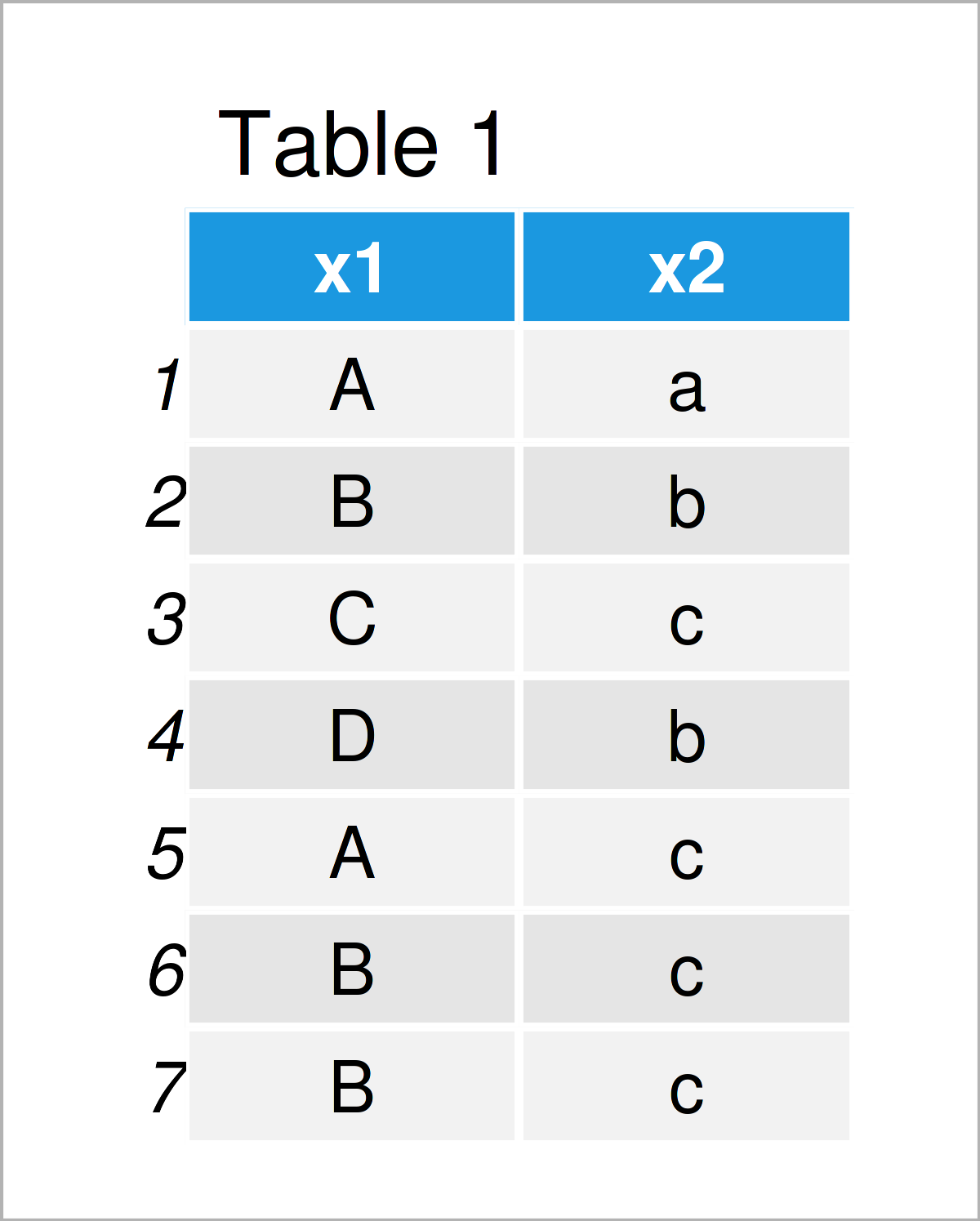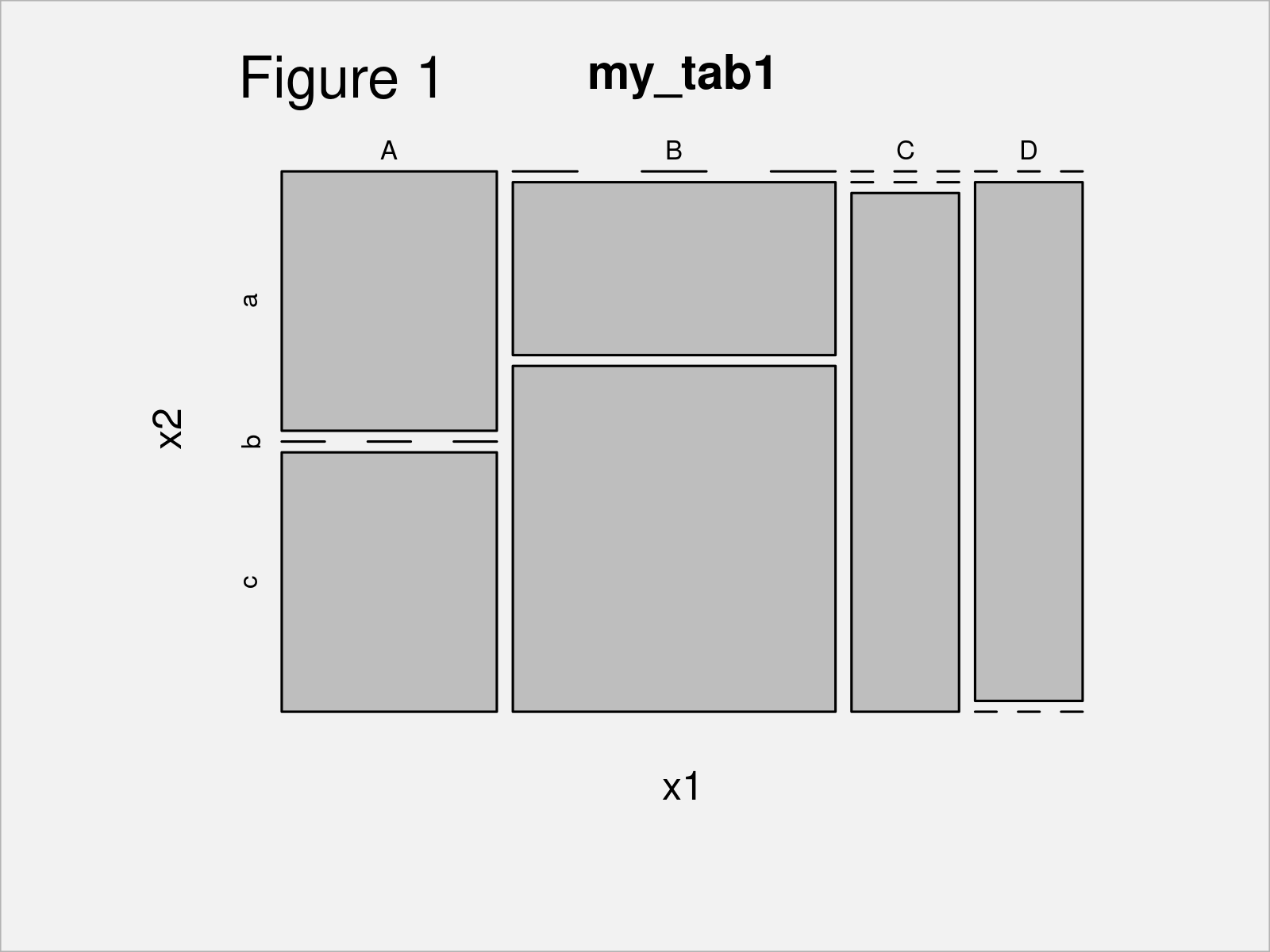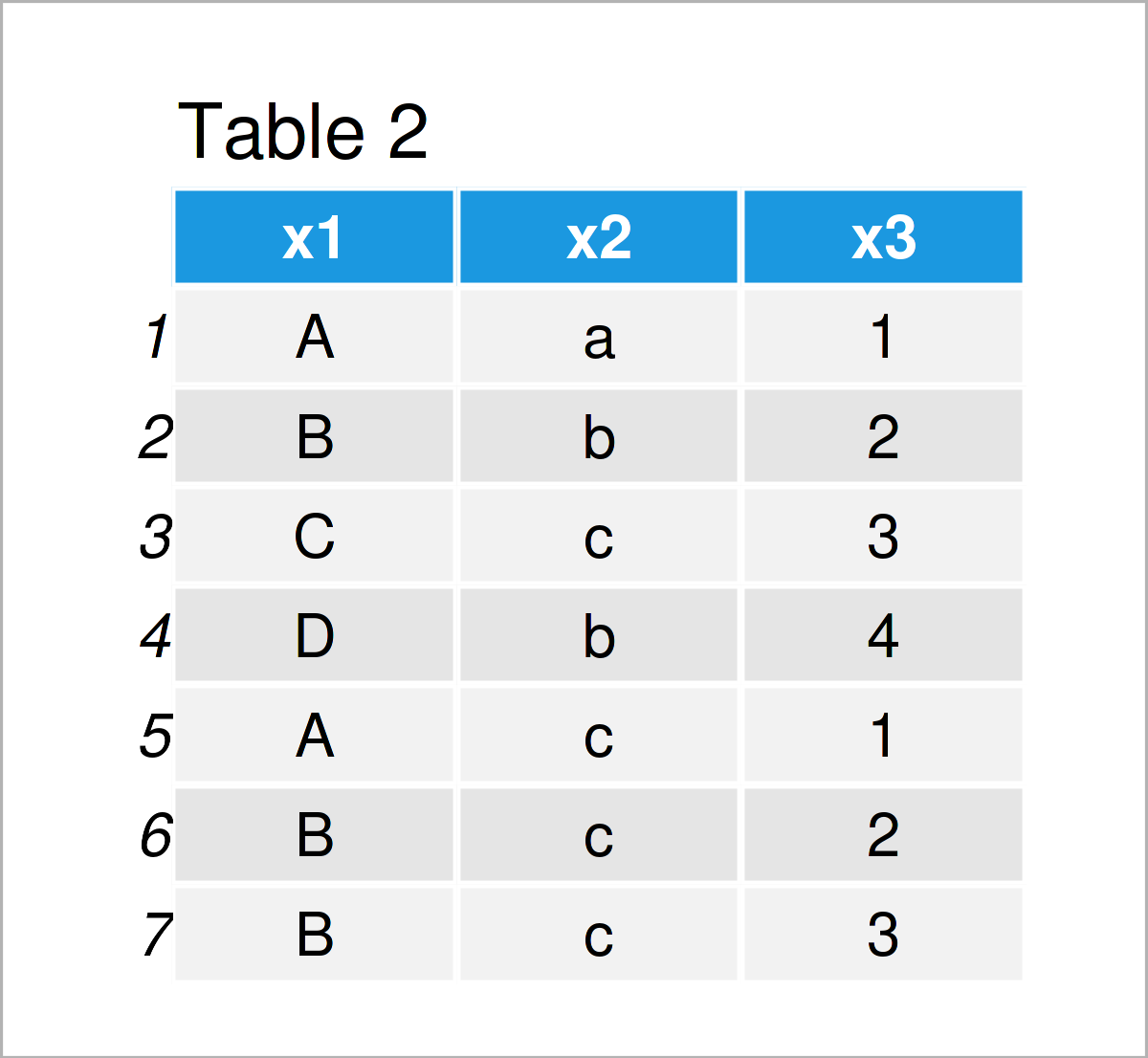How to Count the Sum of Continuous Variables in Twoway Table in R
Contingency Table in R (5 Examples)
In this R tutorial you'll learn how to make a contingency table.
The content of the article looks like this:
Here's the step-by-step process.
Creating Example Data
Initially, let's construct some exemplifying data:
data <- data. frame (x1 = c(LETTERS[ 1 : 4 ], "A", "B", "B" ), # Create example data frame x2 = c(letters[ 1 : 3 ], "b", "c", "c", "c" ) ) data # Print example data frame
data <- data.frame(x1 = c(LETTERS[1:4], "A", "B", "B"), # Create example data frame x2 = c(letters[1:3], "b", "c", "c", "c")) data # Print example data frame

As you can see based on Table 1, the example data is a data frame containing seven rows and two variables.
Example 1: Create Two-way Contingency Table
This example illustrates how to make a two-way contingency table (or cross tabulation / crosstab) in the R programming language.
For this task, we can apply the table() function to our example data frame as shown in the following R code:
my_tab1 <- table(data) # Create two-way contingency table my_tab1 # Print two-way contingency table # x2 # x1 a b c # A 1 0 1 # B 0 1 2 # C 0 0 1 # D 0 1 0
my_tab1 <- table(data) # Create two-way contingency table my_tab1 # Print two-way contingency table # x2 # x1 a b c # A 1 0 1 # B 0 1 2 # C 0 0 1 # D 0 1 0
The previous output of the RStudio console shows a two-way cross tabulation of the two variables in our data frame. For instance, the combination of A and a occurs once, and the combination of B and a occurs not at all.
Example 2: Draw Plot of Contingency Table
In this example, I'll demonstrate how to draw a plot of a 2×2 contingency table.
The following R code uses the plot() function provided by Base R to create a mosaic plot of the table object we have constructed in Example 1:
plot(my_tab1) # Plot contingency table
plot(my_tab1) # Plot contingency table

Figure 1 shows the output of the previous R programming syntax – A mosaic graphic showing the cross tabulation of the two columns in our example data.
By the way, it is also possible to draw frequency count tables in a graph. For more info, have a look here.
Example 3: Add Margins to Contingency Table
Example 3 shows how to add the sum of each row and each column of a table object (i.e. the margins) to this table.
To achieve this, we can apply the addmargins function as illustrated below:
my_tab2 <- addmargins(my_tab1) # Add margins to contingency table my_tab2 # Print contingency table with margins # x2 # x1 a b c Sum # A 1 0 1 2 # B 0 1 2 3 # C 0 0 1 1 # D 0 1 0 1 # Sum 1 2 4 7
my_tab2 <- addmargins(my_tab1) # Add margins to contingency table my_tab2 # Print contingency table with margins # x2 # x1 a b c Sum # A 1 0 1 2 # B 0 1 2 3 # C 0 0 1 1 # D 0 1 0 1 # Sum 1 2 4 7
The previous table contains the same values as the table we have created in Example 1, plus the margins of each row and column.
Example 4: Create Contingency Table with Proportions
The following R programming syntax shows how to get a two-way contingency table with proportions (or probabilities).
To do this, we can apply the prop.table function as shown in the following R syntax:
my_tab3 <- prop. table (my_tab1) # Contingency table with proportions my_tab3 # Print contingency table with proportions # x2 # x1 a b c # A 0.1428571 0.0000000 0.1428571 # B 0.0000000 0.1428571 0.2857143 # C 0.0000000 0.0000000 0.1428571 # D 0.0000000 0.1428571 0.0000000
my_tab3 <- prop.table(my_tab1) # Contingency table with proportions my_tab3 # Print contingency table with proportions # x2 # x1 a b c # A 0.1428571 0.0000000 0.1428571 # B 0.0000000 0.1428571 0.2857143 # C 0.0000000 0.0000000 0.1428571 # D 0.0000000 0.1428571 0.0000000
Example 5: Create Three-way Contingency Table
So far, we have created different types of two-way contingency tables. However, it is also possible to perform a three-way cross tabulation.
For this, we first have to extend our example data frame by another variable:
data_three <- data. frame (data, # Create data frame with three variables x3 = c( 1 : 4, 1 : 3 ) ) data_three # Print data frame with three variables
data_three <- data.frame(data, # Create data frame with three variables x3 = c(1:4, 1:3)) data_three # Print data frame with three variables

Table 2 shows the output of the previous R programming code – i.e. a data frame with three variables.
Next, we can apply the table command to this data frame to create a three-way contingency table:
my_tab4 <- table(data_three) # Create three-way contingency table my_tab4 # Print three-way contingency table # , , x3 = 1 # # x2 # x1 a b c # A 1 0 1 # B 0 0 0 # C 0 0 0 # D 0 0 0 # # , , x3 = 2 # # x2 # x1 a b c # A 0 0 0 # B 0 1 1 # C 0 0 0 # D 0 0 0 # # , , x3 = 3 # # x2 # x1 a b c # A 0 0 0 # B 0 0 1 # C 0 0 1 # D 0 0 0 # # , , x3 = 4 # # x2 # x1 a b c # A 0 0 0 # B 0 0 0 # C 0 0 0 # D 0 1 0
my_tab4 <- table(data_three) # Create three-way contingency table my_tab4 # Print three-way contingency table # , , x3 = 1 # # x2 # x1 a b c # A 1 0 1 # B 0 0 0 # C 0 0 0 # D 0 0 0 # # , , x3 = 2 # # x2 # x1 a b c # A 0 0 0 # B 0 1 1 # C 0 0 0 # D 0 0 0 # # , , x3 = 3 # # x2 # x1 a b c # A 0 0 0 # B 0 0 1 # C 0 0 1 # D 0 0 0 # # , , x3 = 4 # # x2 # x1 a b c # A 0 0 0 # B 0 0 0 # C 0 0 0 # D 0 1 0
As you can see, the previous output has created a list object. Each element of this list shows a two-way contingency table given a certain value in the third variable of our input data.
For instance, the first list element of the previously shown list contains a two-way contingency table for the case when x3 is equal to the value 1.
Video & Further Resources
Have a look at the following video on the Statistics Globe YouTube channel. I explain the R programming codes of this article in the video.
The YouTube video will be added soon.
In addition, you may want to have a look at some of the other tutorials on this website. Some articles can be found below:
- Contingency Table Across Multiple Columns
- Extend Contingency Table with Proportions & Percentages
- How to Create a Frequency Table in R
- R Programming Overview
You have learned in this tutorial how to calculate and create a contingency table in R. Don't hesitate to let me know in the comments, if you have any further questions.
rodriguezantogginly.blogspot.com
Source: https://statisticsglobe.com/contingency-table-r
0 Response to "How to Count the Sum of Continuous Variables in Twoway Table in R"
Post a Comment